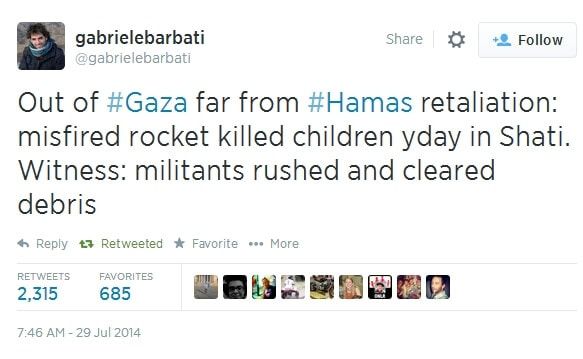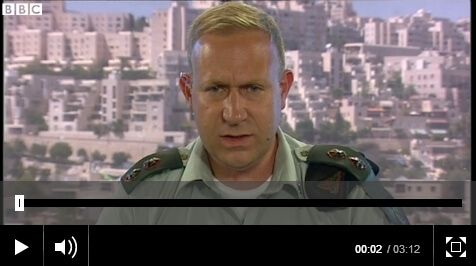Today’s Top Stories
1. For the third time now, Palestinian rockets were found in an UNRWA school. Three is a magic number because, as a senior editor once told me, the first time something happens, you say hmmmm. The second time, maybe it’s a coincidence. But three? That’s a pattern screaming for scrutiny. Later in the day, the Times of Israel reported that a booby-trapped tunnel opening was found in a UNRWA health clinic near Khan Yunis.
2. Palestinians say 15 people were killed by IDF shelling of a UNRWA school where Palestinians sought shelter. Not a lot of details yet, but reports in several papers such as AP quoted the army explanation:
The Israeli military said mortar shells had been fired from near the school, and that soldiers fired back.
See also BBC, where Lt. Col. Peter Lerner elaborated on what was known about the incident.
3. A sign of desperation?
Hamas invites Hezbollah to join in fighting against Israel
4. As the Twitterverse Watches AP in Horror: The wire service is revising its Twitter guidelines. What does Israel have to do with this fiasco?
5. Playing the Blame Game at Israel’s Expense: Care to guess who academia blames for the Gaza crisis?
6. 3 Important Things to Know About the Gaza Siege: Bottom line: There has never been a “siege.”
7. WSJ Columnist: “Palestine Effect” Makes People Irrational: It’s “the abrupt and often total collapse of logical reasoning, skeptical intelligence and ordinary moral judgment whenever the subject of Palestinian suffering arises.”
Operation Protective Edge
• For details on today’s developments, see live-blogs at the Jerusalem Post, Haaretz, Times of Israel, and i24 News.
• Haaretz: The Foreign Ministry wants to push an Israeli-sponsored initiative in the UN Security Council to end the war:
He said the ministry believes such a move would minimize Hamas’ international legitimacy and advance Israeli interests, such as disarming Gaza and returning the Palestinian Authority to the Strip.
• According to the Jerusalem Post, Tehran’s playing with matches again:
Tehran is going to provide missiles to Palestinians in the West Bank, Amir Mousavi, a former adviser to the Iranian defense minister, says.
• European anti-Semitism must be getting serious if it’s a Newsweek cover story. The anti-war protests are just the tip of the iceberg.
• Israeli pilot to NBC News: Hamas deliberately puts civilians in harm’s way.
Omri said Palestinian fighters often operate among civilians. “Hamas is doing everything they can to bring the civilians into this conflict. We are seeing Hamas preventing people from being vacated from the area, calling them back into neighborhoods where we announced we are about to perform attacks. And so in order to for us to protect our civilians we have almost got no option but to drop bombs on rocket launchers or ammunition stashes that are actually buried between residential areas.”
• Despite rockets and tunnels, Israeli farmers remain hopeful
• This will make your antennae twitch. Saudi Arabia’s former intelligence chief, Prince Turki al-Faisal, blames Hamas for Palestinian deaths in Gaza. He’s still one of the more heavyweight officials in the Saudi monarchy.
• Denmark‘s prime minister refused to sign a letter with other Nordic social democratic leaders condemning Israel.
• Finance Ministry figures indicate the economic effects of the Gaza conflict are still manageable, YNet reports.
Media Angles
• I think Hamas is going to be looking for Italian journalist Gabriele Barbati. He confirmed on Twitter the IDF’s account of errant Hamas shells hitting the Shati refugee camp earlier this week. 
• Worth reading: Steven Stotsky, one of our colleagues at CAMERA, explains in Time explain why you should treat Palestinian casualties with care:
Analyses of the casualties listed in the daily reports published by the Palestinian Center for Human Rights, a Gaza-based organization operating under Hamas rule, indicate that young males ages 17 to 30 make up a large portion of the fatalities, and a particularly noticeable spike occurs between males ages 21 to 27, a pattern consistent with the age distribution typically found among combatants and military conscripts. Palestinian sources attempt to conceal this discrepancy with their public message by labeling most of these young men as civilians. Only a minority is identified as members of armed groups. As a result, the PCHR calculates civilian fatalities at 82% as of July 26. PCHR provides the most detailed casualty reports of the various Palestinian agencies from Gaza that provide figures to the media and to international organizations like the UN. Its figures closely match those of the Hamas-run Gazan Health Ministry and other groups . . .
A more plausible explanation is that the age demographic of the fatalities reflects the relative involvement of different age bands in hostilities. Of course, some of those in the most represented age-bands aren’t combatants. However, balancing that, Palestinian and Israeli sources confirm that a portion of the fatalities over age 40 were senior Hamas or Islamic Jihad operatives targeted by Israel . . .
In light of evidence—provided by groups that monitor Arabic language media (like the Middle East Media Research Institute)—that Hamas has instructed Gazans to describe anyone killed as a civilian, journalists have a responsibility to convey this uncertainty to their audiences and not present figures provided by Hamas and Hamas-affiliated sources as unqualified fact.
• Careful with those hashtags, Dan Rivers!
• Jonathan Tobin: Pictures don’t justify anti-Israel media bias
• Although James Ball will disagree, Douglas Murray deconstructs Channel 4’s veteran journalist Jon Snow.
• Andrew Bolt wades into the Australian furor over Mike Carlton‘s take on Gaza.
• Israeli officials continued their media offensive. Cabinet minister Yuval Steinitz and Knesset member Nachman Shai discussed the conflict with CNN.
Commentary/Analysis
• Over at The Hill, Professor Lauren Blank articulates the legal distinctions between asymmetry and proportionality.
Indeed, widely different numbers of civilian casualties between two sides in a conflict says nothing about the proportionality of particular attacks on specific targets. News reports of civilians killed or wounded in the course of combat in Gaza tell us of tragedy and loss. They tell us of the horrors of urban warfare and the challenges of fighting against a terrorist group bent on using the civilian population as a shield for its operatives, rocket launchers and weapons caches. They tell us that we must be more vigilant in condemning and holding accountable those who exploit civilians for tactical and strategic advantage. They tell us that commanders launching attacks must fulfill all obligations to minimize civilian harm and be held accountable when they do not. But numbers of casualties alone do not provide answers about proportionality or legality — you need both law and all the facts, not just numbers, to do that.
• Irish Independent columnist Carol Hunt wonders why Israel gets blamed more when it comes to the deaths of innocent children in war.
• Come on UN, what will you do about Hamas war crimes? asks Robert Mitchinson.
• CNN discussed the terror tunnel threat and how to neutralize it with US Maj. Gen. James Marks.
• This Washington Post staff-ed gets it:
Israel is demanding that Hamas be disarmed as a part of any peace. While the Obama administration rhetorically endorsed that goal, it doesn’t seem to regard it as feasible in the short term. In our view, the objective should be explored more seriously. It might be possible, for example, to make Hamas’s surrendering of its missiles the condition for steps that would enable Gaza’s economic development, such as the opening of a seaport — a trade-off that most Gazans would welcome. At a minimum, new security provisions should aim at preventing Hamas from importing more military supplies.
• Congressman Keith Ellison took to the Washington Post to call on Israel to end the Gaza blockade.
• Clifford May’s advice to Israel: Endure the slander.
• See also Elhanan Miller (Topple Hamas, or come to terms with it?), AP (What endgame might look like), Efraim Inbar (Don’t give them money), David Horovitz (Why Bibi doesn’t want to go “all the way”), Diana Bletter’s observations on life in Israel (Wall St. Journal via Google News), and Professor Gerald Steinberg (Wall St. Journal via Google News).
Featured image: CC BY-SA flickr/theilr
For more, see yesterday’s Israel Daily News Stream and join the Israel Daily News Stream on Facebook.





